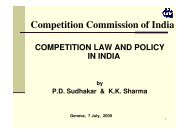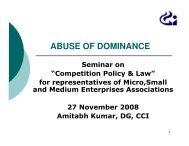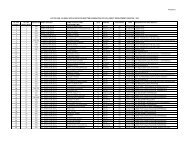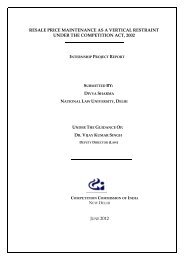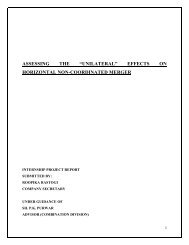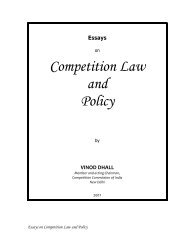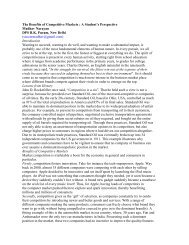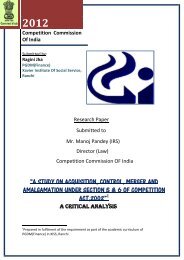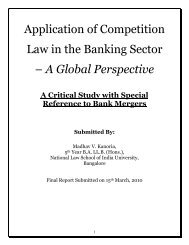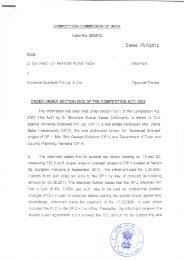applicability of competition law principles on public sector ...
applicability of competition law principles on public sector ...
applicability of competition law principles on public sector ...
Create successful ePaper yourself
Turn your PDF publications into a flip-book with our unique Google optimized e-Paper software.
OECD TOOLKIT<br />
(A) Limits the number or range <str<strong>on</strong>g>of</str<strong>on</strong>g> suppliers<br />
This is likely to be the case if a clause:<br />
i. Grants exclusive rights for a supplier to provide goods or services<br />
ii. Establishes a license, permit or authorizati<strong>on</strong> process as a requirement <str<strong>on</strong>g>of</str<strong>on</strong>g> operati<strong>on</strong>.<br />
Creates natural barriers affecting prospective entrants or significantly raises cost <str<strong>on</strong>g>of</str<strong>on</strong>g><br />
entry or exit by a supplier.<br />
iii. Limits to the number <str<strong>on</strong>g>of</str<strong>on</strong>g> firms permitted to enter the market<br />
iv. Limits the ability <str<strong>on</strong>g>of</str<strong>on</strong>g> some types <str<strong>on</strong>g>of</str<strong>on</strong>g> suppliers to provide a good or service<br />
v. Has barriers, based <strong>on</strong> either regulati<strong>on</strong>s or custom, that prevent women from<br />
commencing business in the relevant market(s) and/or expanding an existing<br />
business, or that make it difficult for them to do so.<br />
vi. Creates a geographical barrier to the ability <str<strong>on</strong>g>of</str<strong>on</strong>g> companies to supply goods services<br />
or labour, or invest capital<br />
(B) Limits the ability <str<strong>on</strong>g>of</str<strong>on</strong>g> suppliers to compete<br />
This is likely to be the case if a clause:<br />
i. Limits sellers’ ability to set the prices for goods or services<br />
ii. Limits freedom <str<strong>on</strong>g>of</str<strong>on</strong>g> suppliers to advertise or market their goods or services<br />
iii. Benefits or grants preferential treatment to the state-owned enterprise/s that<br />
operate in the market/s being assessed<br />
iv. Sets standards for product quality that provide an advantage to some suppliers over<br />
others or that are above the level that some well-informed customers would choose<br />
v. Allows under-development <str<strong>on</strong>g>of</str<strong>on</strong>g> transport or other infrastructure in some territories to<br />
give incumbent firms m<strong>on</strong>opoly status<br />
vi. Limits <str<strong>on</strong>g>competiti<strong>on</strong></str<strong>on</strong>g>, transparency and fairness in government procurement<br />
vii. Significantly raises costs <str<strong>on</strong>g>of</str<strong>on</strong>g> producti<strong>on</strong> for some suppliers relative to others<br />
(especially by treating incumbents differently from new entrants)<br />
(C)Reduces the incentive <str<strong>on</strong>g>of</str<strong>on</strong>g> suppliers to compete<br />
This is likely to be the case if a clause:<br />
i. Creates a self-regulatory or co-regulatory regime<br />
ii. Requires or encourages informati<strong>on</strong> <strong>on</strong> supplier outputs, prices, sales or costs to be<br />
published<br />
iii. Exempts the activity <str<strong>on</strong>g>of</str<strong>on</strong>g> a particular industry or group <str<strong>on</strong>g>of</str<strong>on</strong>g> suppliers from the<br />
operati<strong>on</strong> <str<strong>on</strong>g>of</str<strong>on</strong>g> the general <str<strong>on</strong>g>competiti<strong>on</strong></str<strong>on</strong>g> <str<strong>on</strong>g>law</str<strong>on</strong>g><br />
(D) Regulatory and policy barriers<br />
This is likely to be the case if a clause:<br />
i. Creates ‘policy uncertainty’ through <strong>on</strong>erous, costly or time-c<strong>on</strong>suming regulati<strong>on</strong> or<br />
frequent changes in regulati<strong>on</strong>s<br />
ii. Allows unequal applicati<strong>on</strong> <str<strong>on</strong>g>of</str<strong>on</strong>g> <str<strong>on</strong>g>law</str<strong>on</strong>g>s or regulati<strong>on</strong>s<br />
(E) Limits the choices and informati<strong>on</strong> available to customers<br />
This is likely to be the case if a clause:<br />
i. Limits the ability <str<strong>on</strong>g>of</str<strong>on</strong>g> c<strong>on</strong>sumers to decide from whom they purchase<br />
ii. Reduces mobility <str<strong>on</strong>g>of</str<strong>on</strong>g> customers between suppliers <str<strong>on</strong>g>of</str<strong>on</strong>g> goods or services by increasing<br />
the explicit or implicit costs <str<strong>on</strong>g>of</str<strong>on</strong>g> changing suppliers<br />
iii. Fundamentally changes informati<strong>on</strong> required by buyers to shop effectively<br />
14



